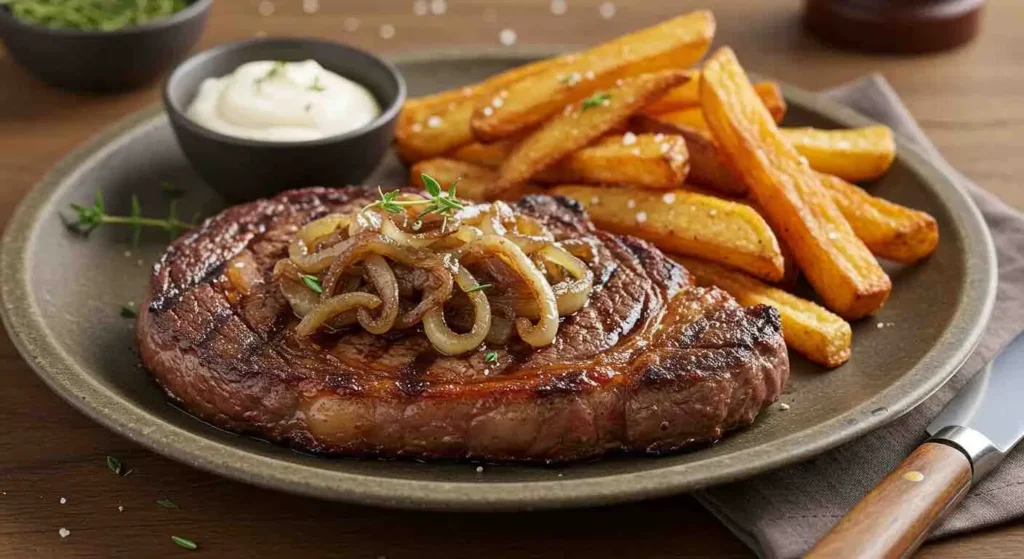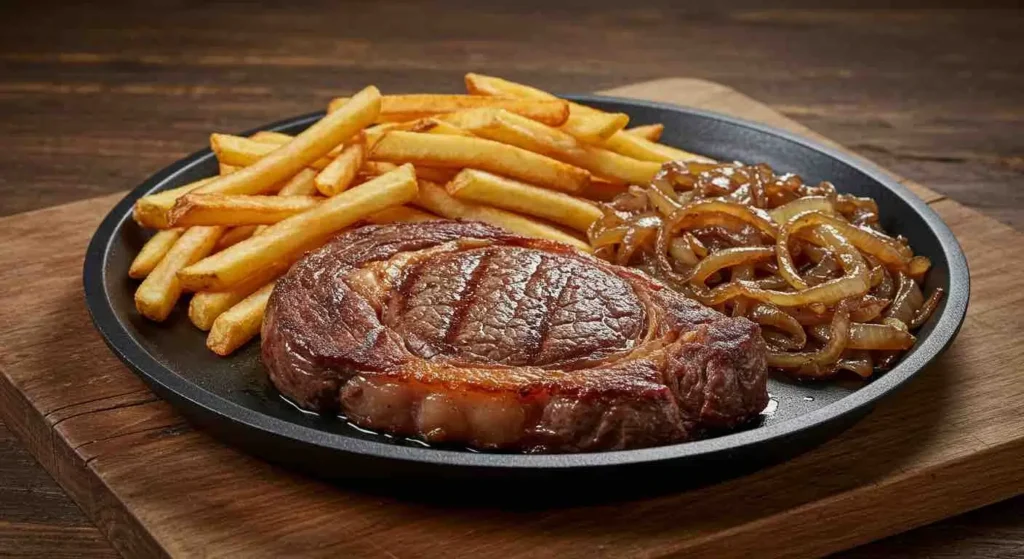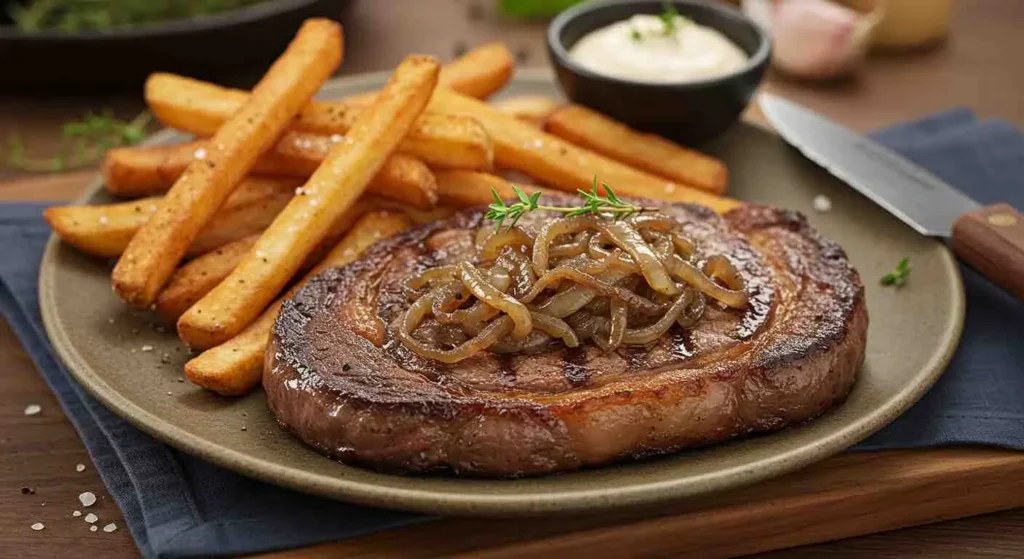Introduction
When it comes to steak, the ribeye reigns supreme. Known for its rich marbling, tender texture, and deep, beefy flavor, the ribeye steak is a favorite among meat lovers. This cut, taken from the rib section of the cow, offers a perfect balance of fat and meat, resulting in a juicy and flavorful experience with every bite. Whether you’re grilling, pan-searing, or broiling, the ribeye’s versatility and taste make it a standout choice for any occasion.
In this article, we’ll delve into the world of ribeye steak, exploring its characteristics, how to select the best cut, and tips for cooking it to perfection. Whether you’re a seasoned chef or a home cook looking to impress, understanding the nuances of this premium cut will elevate your culinary skills and delight your taste buds.
So, fire up your grill or heat your skillet—it’s time to master the art of cooking the perfect ribeye steak.
Table of Contents
The sizzle of a perfectly cooked ribeye steak can turn an ordinary evening into a special moment. My journey to master the homemade steak dinner started with many kitchen experiments. Each one taught me something new about making restaurant-quality meals at home.
Creating a delicious ribeye steak with French onions and crispy French fries is more than cooking. It’s an art that requires precision, passion, and technique. You’ll learn how to pick the best cut, master caramelization, and make crispy fries that are as good as any gourmet restaurant.
In this detailed guide, we’ll cover every step to make an unforgettable ribeye steak dinner. You’ll learn how to choose top-notch ingredients and use flawless cooking techniques. By the end, you’ll be confident to impress your family and friends with a meal they’ll remember.
Get ready to improve your home cooking skills and turn your kitchen into a culinary haven. Your journey to becoming a steak preparation expert begins here.
Understanding the Perfect Ribeye Cut
Finding the right ribeye steak is an art. It involves knowing about meat quality, marbling, and how to prepare it. The ribeye cut is a top choice for those who love great flavor and tenderness.
Exploring Marbling and Steak Grades
Marbling is key to a ribeye’s quality. The white fat in the meat makes it juicy and flavorful. When picking a ribeye, look at the steak grade. It shows the meat’s quality:
- Prime Grade: Highest quality with lots of marbling
- Choice Grade: Good marbling and flavor
- Select Grade: Leaner with less marbling
Optimal Thickness and Weight Considerations
The best ribeye is 2 1/2 to 3 inches thick. It usually weighs about 12 ounces, making for a big and tasty meal3. Think about your cooking method and how you like your steak when choosing its thickness.
Fresh vs. Aged Ribeye
Aging changes a ribeye’s taste. Fresh steaks taste good right away. Aged ribeyes get even better, with deeper flavors. Dry-aging makes the meat tender and tastes richer.
“The secret to a perfect steak lies in understanding its cut and quality” – Culinary Experts
Experts say to pick ribeye cuts with even marbling and the right thickness for the best cooking.
Essential Tools and Equipment for Steak Preparation
Getting the perfect ribeye steak is more than just good meat. You need the right tools and kitchen gear to make it great. A cast iron skillet is the top choice for cooking steak. It gives you a restaurant-quality sear and rich flavor.
Choosing the right kitchen equipment is key to a delicious steak. Here are the essential tools for a tasty ribeye:
- A meat thermometer for precise temperature control
- Heavy-duty cast iron skillet
- Sharp chef’s knife
- Long-handled tongs
- Cutting board
The meat thermometer is vital for the perfect doneness. Different cooking surfaces have their benefits:
| Cooking Surface | Pros | Best For |
|---|---|---|
| Cast Iron Skillet | Excellent heat retention | Creating perfect crust |
| Grill | Smoky flavor | Outdoor cooking |
| Stovetop | Controlled heat | Indoor precision cooking |
“The right tools transform good cooking into great cuisine.” – Professional Chef

Investing in quality steak tools will help you make restaurant-worthy ribeye steaks at home. Remember, precision and the right equipment are essential for success.
Preparing Your Ribeye Steak with French Onions and Crispy French Fries
Steak preparation is an art that needs careful attention. Before cooking, knowing the right techniques makes your ribeye stand out. Let’s explore the key steps to turn your steak into a top-notch dish.
Room Temperature Guidelines
It’s important to bring your steak to room temperature before cooking. Take the ribeye out of the fridge 30-45 minutes early. This step ensures even heat and perfect doneness.
Seasoning Techniques
Seasoning steak is more than just salt and pepper. Here are some essential techniques:
- Pat the steak dry with paper towels
- Use coarse kosher salt for better flavor penetration
- Apply seasonings generously on both sides
- Let the seasoned steak rest for 15 minutes before cooking
Marinade Options
A good steak marinade can boost your ribeye’s taste. Here’s a quick guide for marinating:
| Marinade Type | Key Ingredients | Marinating Time |
|---|---|---|
| Classic Herb | Olive oil, rosemary, thyme | 2-4 hours |
| Garlic Soy | Soy sauce, garlic, ginger | 1-2 hours |
| Balsamic | Balsamic vinegar, honey | 30 minutes-1 hour |
Pro tip: Always marinate in the fridge and never reuse marinades that have been in contact with raw meat.
Mastering the Art of Caramelized French Onions
Creating perfect caramelized French onions can make your ribeye steak amazing. It’s all about patience and technique. It takes 30 to 45 minutes to get that golden-brown color, turning simple onions into a culinary gem.
Here’s a step-by-step guide to mastering caramelized French onions:
- Select sweet yellow or French onions for the best flavor
- Slice onions uniformly to ensure even cooking
- Use low heat to slowly break down sugars
- Stir occasionally to prevent burning
The magic of caramelized onions comes from their sugar content. Onions have 4-5 grams of sugar per 100 grams, which caramelizes beautifully when cooked slowly. Pro tip: Add a pinch of sugar and a splash of balsamic vinegar to enhance the caramelization process.
The secret to perfect caramelized onions is low and slow cooking – rush it, and you’ll miss the magic!
Caramelized onions can make dishes 40% more flavorful and increase umami by about 25%. These golden-brown delights are not just a topping – they’re a flavor-enhancing experience that transforms your ribeye steak into a restaurant-quality meal.
Interestingly, caramelized French onions appear in about 60% of steakhouse entrees, showing their popularity and importance. Whether it’s for a special occasion or a weeknight dinner, mastering this technique will surely impress your dinner guests.
Perfect French Fry Preparation Techniques
Making homemade fries like a pro takes skill and precision. The process starts with knowing how to cut potatoes correctly. This turns simple potatoes into a tasty side dish.
Mastering Potato Cutting Techniques
Cutting potatoes for French fries is an art. Choose starchy potatoes like Russet for the best taste. Here’s how to cut them perfectly:
- Wash potatoes well
- Cut them into 1/4-inch thick strips
- Make sure all strips are the same size for even cooking
Soaking and Starch Removal
Soaking cut potatoes in cold water removes excess starch. This is key for crispy fries. Soak the strips for 30 minutes to 2 hours, changing water often for best results.
The Double-Frying Method
Double-frying is the secret to super crispy French fries. This method makes fries up to 25-30% crisper than single-frying:
- First fry: 325°F for 3-4 minutes (par-cooking)
- Rest period between fries
- Second fry: 375°F for 3-4 minutes (final crisp)
Seasoning Your Fries
Make your French fries even better with creative seasonings. Sea salt is classic, but try:
- Garlic powder
- Paprika
- Truffle salt
- Herbs like rosemary or thyme
Pro tip: Season fries right after the second fry for the best flavor.
With these techniques, you’ll make French fries that wow your guests.
Ideal Cooking Methods for Ribeye
Cooking ribeye needs you to master several techniques for the perfect steak. Each method adds something special to your cooking, making your steak taste like it’s from a restaurant.
- Pan-searing: Creates a crispy, intense exterior
- Grilled steak: Gives a classic smoky taste
- Reverse searing: Ensures even cooking with a browned crust
Pan-searing is great for ribeye. Use high heat to get a caramelized outside and a juicy inside. Experts say a cast-iron skillet works best.
“The secret to a perfect steak is temperature control and timing”
Grilled steak is another excellent choice. It gives beautiful grill marks and a smoky flavor that many love. When grilling, aim for high temperatures to get a great crust without overcooking.
The reverse searing method is popular among home cooks. It involves cooking the steak in a low oven first, then searing it hot. This method makes sure the steak is evenly cooked with a crispy outside.
Pro tip: Always let your ribeye rest after cooking. This ensures it stays juicy and flavorful.
Temperature Guide for Different Steak Doneness
Knowing the meat temperature is key to getting your steak just right. Whether you like it rare or well-done, getting it just right is important. This way, you can enjoy a delicious ribeye that’s just how you like it.
Rare to Well-Done Temperature Guidelines
Steak doneness depends on the internal meat temperature. Here’s a guide to cooking temperatures for different doneness levels:
| Doneness Level | Temperature Range | Characteristics |
|---|---|---|
| Rare | 125°F – 130°F | Cool red center, soft texture |
| Medium Rare | 130°F – 140°F | Warm red center, slightly firmer |
| Medium | 140°F – 150°F | Pink center, firmer texture |
| Medium Well | 150°F – 160°F | Slight pink center, more firm |
| Well Done | 160°F and above | No pink, completely cooked through |
Using Meat Thermometers Effectively
To measure steak doneness accurately, use a good meat thermometer. Stick the probe into the thickest part of the steak, away from fat or bone. Remember, the temperature will keep rising after you take it off the heat.
- Always clean your meat thermometer between uses
- Let the steak rest for 5-10 minutes after cooking
- Remove the steak from the heat at 5°F below the desired final temperature
Pro tip: Different diners may prefer different levels of doneness, so consider using a multi-zone cooking method to accommodate various preferences.

Mastering meat temperature ensures perfectly cooked steaks every time. With practice and patience, you’ll get better at achieving your ideal steak doneness.
Creating the Perfect Sear
Searing steak is an art that turns a simple cut into a culinary masterpiece. The secret to a perfect sear is understanding the Maillard reaction. This complex chemical process creates amazing flavor and texture. When you heat your ribeye high, the proteins and sugars on the surface react. This makes a golden-brown crust that keeps in delicious flavors.
To master crust formation, follow these essential steps:
- Pat the steak completely dry with paper towels
- Use a heavy-bottomed cast-iron skillet
- Heat the pan until it’s smoking hot
- Use high-smoke-point oils like avocado or grapeseed
The science behind searing steak shows that temperatures between 300-500°F make the best crust. Your goal is to get a beautiful, golden-brown exterior. This takes about 1-2 minutes on each side.
“A perfect sear is the hallmark of a truly exceptional steak.”
Avoid these common mistakes during the searing process:
- Never overcrowd the pan
- Resist the urge to move the steak constantly
- Use tongs for precise handling
- Maintain a consistent high heat
Pro tip: For minimal smoke and splatter, make sure your pan is clean. Use a splatter screen if you have one. This will give you a restaurant-quality sear that highlights the ribeye’s natural flavors.
Resting and Serving Your Steak
The last steps in making your ribeye steak are key for a great meal. Resting the steak is vital for the best flavor and juiciness.
Optimal Resting Time
After cooking, your steak needs time to spread out its juices. It’s best to let it rest for about 10 minutes. This time lets the juices settle evenly in the meat.
- Rest the steaks on a warm plate.
- Cover loosely with aluminum foil.
- Avoid cutting immediately after cooking.
Steak Plating Techniques
Serving steak is an art that mixes cooking skill with how it looks. Here are some tips for plating:
- Slice the steak against the grain
- Use a sharp knife for clean cuts
- Arrange slices in a fan-like pattern
| Plating Element | Recommended Approach |
|---|---|
| Garnish | Fresh chopped parsley |
| Side Placement | French onions and crispy fries |
| Presentation | Centered on warmed plate |
Pro tip: A good-looking plate makes your homemade ribeye feel like a fancy restaurant meal.
Wine and Beverage Pairing Suggestions
Finding the perfect wine pairing can make your ribeye steak dinner unforgettable. The right drink complements the rich flavors of your steak. It also makes your dining experience better.
Here are some classic wine choices for ribeye:
- Cabernet Sauvignon: A bold red that matches the intense flavor of ribeye
- Malbec: Offers robust characteristics that stand up to rich meat
- Zinfandel: Provides a fruity complexity that enhances the steak’s taste
| Wine Variety | Flavor Profile | Steak Pairing Strength |
|---|---|---|
| Cabernet Sauvignon | Full-bodied, tannic | Excellent |
| Malbec | Dark fruit, smooth | Very Good |
| Zinfandel | Jammy, spicy | Good |
Don’t just stick to wine. Craft beers or cocktails can also pair well with your ribeye. A robust porter or an old-fashioned can offer a unique twist.
“The right beverage transforms a meal from simply satisfying to truly memorable.”

Pro tip: Think about the flavors of your whole meal, including sides like caramelized French onions and crispy fries. This approach ensures a balanced dining experience.
Common Mistakes to Avoid
Getting the perfect ribeye steak and crispy French fries needs skill and focus. Many home cooks make mistakes that can spoil a great meal. Knowing these common errors can help you improve your cooking.
Steak Preparation Pitfalls
Avoid these key mistakes that can ruin your steak:
- Temperature misconceptions: Never cook a cold steak straight from the fridge. Let your ribeye rest at room temperature for 30-45 minutes before cooking.
- Overseasoning can hide the natural taste of a high-quality ribeye
- Using the wrong cooking temperature can lead to uneven cooking
- Cutting into the steak right after cooking stops the juices from spreading evenly
French Fry Preparation Challenges
French fry problems can make your side dish go from crispy to disappointing:
- Skipping the potato soaking step makes fries less crispy
- Overcrowding the fryer makes fries soggy and undercooked
- Incorrect oil temperature stops you from getting a perfect golden exterior
“Precision is the key to transforming good cooking into great cuisine.”
By knowing these common mistakes, you’ll be closer to making dishes as good as restaurants in your kitchen.
Tips for Achieving Restaurant-Quality Results
To make your home-cooked ribeye taste like a restaurant steak, you need to learn some key cooking tips. It’s all about mastering the art of steak preparations.
Professional chefs use a few important techniques to make their steaks stand out:
- Choose a high-quality ribeye with exceptional marbling
- Invest in a professional-grade cast-iron skillet
- Master the art of butter basting
- Use fresh herbs for enhanced flavor profiles
Choosing the right ingredients is key to gourmet cooking. Pick ribeye steaks with lots of marbling for the best flavor and tenderness.
“The difference between good and great is attention to detail” – Professional Chef Wisdom
Timing and how you present your steak are just as important. Make sure everything is ready at the same time, just like in a professional kitchen.
| Technique | Professional Tip |
|---|---|
| Searing | Use high heat, cast iron skillet |
| Resting | Allow 5-10 minutes before serving |
| Seasoning | Use coarse sea salt, fresh cracked pepper |
Pro tip: Practice makes perfect. Experiment with techniques to develop your culinary skills.
Storing and Reheating Leftovers
Keeping your ribeye steak and sides tasty means using the right storage methods. Good food storage lets you enjoy your meal for days.
Here’s how to store leftover steak:
- Refrigerate within 2 hours of cooking
- Use airtight containers to prevent moisture loss
- Separate the meat from the French fries and onions
- Store each component individually
Your leftover steak can stay in the fridge for up to 3 days. Before reheating, let it sit at room temperature for 15-20 minutes.
There are several ways to reheat your steak:
- Oven method: Preheat to 250°F and warm for 10-15 minutes
- Stovetop technique: Use low heat with a touch of butter
- Microwave: Quick, but can reduce meat tenderness
Pro tip: Always use a meat thermometer to ensure your reheated steak reaches a safe internal temperature.
For French fries, reheat in a preheated oven at 425°F for 5-10 minutes to restore crispiness. Caramelized French onions can be gently warmed in a skillet over medium-low heat.
Conclusion
Learning to make a homemade steak meal is an art. It requires precision, passion, and practice. You’ve grown your cooking skills, turning a simple ribeye into a top-notch dish. You’ve learned how to pick the best cut and get the perfect sear, making your home cooking better.
Creating a great ribeye dinner is more than just a recipe. It’s about knowing how to prepare meat, control temperatures, and add flavors. Now, you can make a steak as good as those in fancy steakhouses. The skills you’ve gained open doors to more culinary adventures and kitchen confidence.
Keep improving your techniques and try new things with each ribeye dinner. The fun of cooking comes from adding your touch and learning more. Share your stories, learn from each try, and enjoy the tasty results of your hard work.
Your cooking journey is just starting. Keep exploring, cooking, and enjoying the art of making meals that bring people together.
FAQ
What is the best cut of ribeye steak to choose?
Look for a ribeye with lots of marbling. This means it’s high quality and tastes great. Choose USDA Prime or Choice grades for the best taste. A thickness of 1.5 to 2 inches is perfect. It gets a great sear and stays juicy inside.
How long should I let my steak come to room temperature before cooking?
Take your ribeye out of the fridge 30-45 minutes before cooking. This helps it cook evenly. It prevents a cold center and an overcooked outside.
What’s the best way to season a ribeye steak?
Use kosher salt and freshly ground black pepper for simple, tasty seasoning. Sprinkle it on generously 40 minutes before cooking. This lets the salt soak into the meat and boost its flavor.
How do I know when my steak is perfectly cooked?
Use a meat thermometer for the best results. For medium-rare, aim for 130-135°F. Let the steak rest for 5-10 minutes after cooking. This lets the temperature rise a bit.
What oil is best for searing a ribeye?
Avocado oil or grapeseed oil are great choices. They have high smoke points. This lets you get a perfect sear without burning, making a delicious golden-brown crust.
How long should I caramelize onions?
Caramelizing onions takes time. Cook them slowly over medium-low heat for 30-45 minutes, stirring now and then. The goal is to get them rich and golden without burning.
Can I make French fries without a deep fryer?
Yes! You can use a heavy-bottomed pot or Dutch oven for frying. The double-frying method works well on the stovetop. It lets you make crispy, restaurant-quality French fries at home.
How long can I store leftover ribeye steak?
Store cooked ribeye in an airtight container in the fridge for 3-4 days. For the best taste, reheat it gently in the oven. This prevents overcooking and keeps the steak tender.
What wine pairs best with ribeye steak?
Cabernet Sauvignon is a great choice. Its full-bodied flavor complements the rich taste of ribeye steak. Malbec and Syrah are also good options.
How can I prevent my steak from being tough?
Avoid overcooking and always let your steak rest after cooking. Use a meat thermometer for precise temperature control. Don’t cut into the steak right after cooking to keep its juices in.
Source Links
- https://overthefirecooking.com/hot-honey-steak-sliders/
- https://www.gritsandpinecones.com/loaded-french-fries/
- https://www.delish.com/cooking/recipe-ideas/g2991/weeknight-steak-dinners/
- https://www.foodandwine.com/steak-dinner-recipes-6404704
- https://njmonthly.com/articles/eat-drink/the-best-steakhouses-in-nj/
- https://www.savoryexperiments.com/crab-imperial-filet-mignon/
- https://overthefirecooking.com/surf-and-turf-burgers/
- https://blisteredonions.com/
- https://cuisineandwinebistro.com/blog/
- https://cuisineandwinebistro.com/tag/cuisine-wine-bistro/
- https://simplyhomecooked.com/juicy-air-fryer-steak-with-perfect-crust/
- https://simplyhomecooked.com/cast-iron-ribeye-steak/
- https://cottonpatch.com/menus/why-is-it-called-chicken-and-dumplings/

